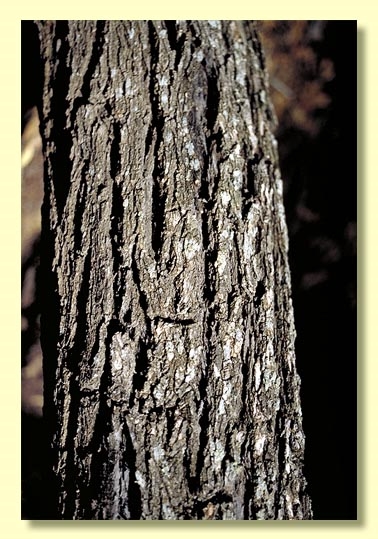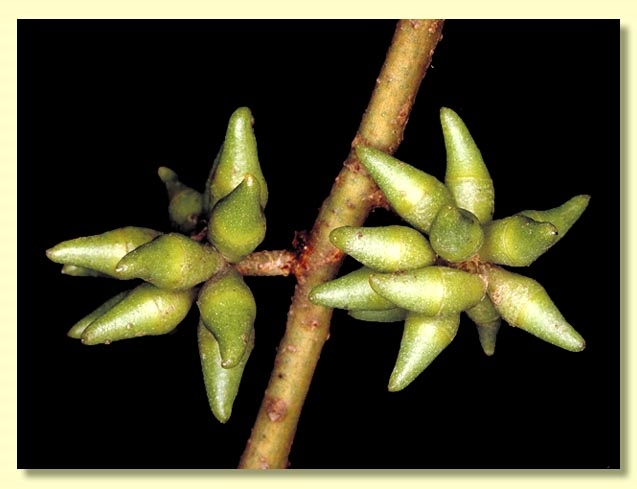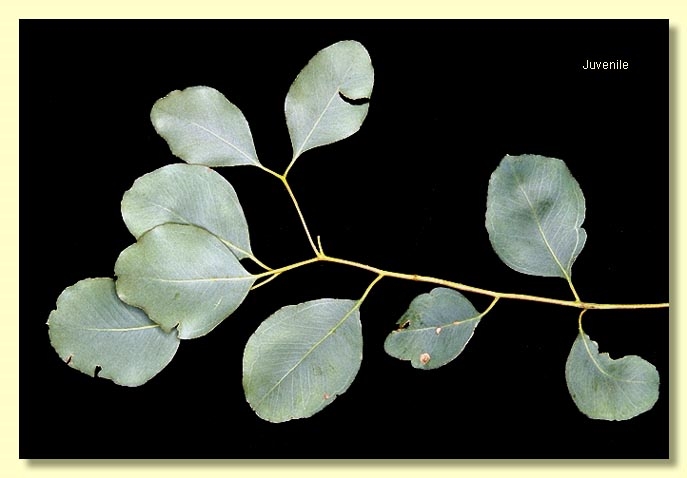Redheart
Euclid - Online edition
Eucalyptus decipiens
Eucalyptus | Symphyomyrtus | Bisectae | Destitutae | Falcatae | Decipientes
T: King George Sound, W.A., K.Hügel s.n.; holo: W.
Eucalyptus concolor Schauer in J.G.C.Lehmann, Pl. Preiss. 1: 129 (1844). T: near Fremantle, W.A., Dec. 1838, L. Preiss 225; syn: n.v.; interior, south-western W.A., L. Preiss 243; syn: n.v. (tentatively placed in synonomy here - syntypes not seen by the authors of EUCLID).
Bark rough throughout, hard, tightly held, fissured grey over yellowish brown.
Branchlets lacking oil glands in the pith.
Juvenile growth (coppice or field seedlings to 50 cm): stems rounded in cross-section; juvenile leaves shortly petiolate, opposite for very few nodes on coppice, soon alternate, orbicular to broadly elliptical or obcordate, 2–6.5 cm long, 2–5 cm wide, base tapering, margin entire or subcrenulate, apex emarginate or rounded and apiculate, dull, slightly blue-green.
Adult leaves alternate, petioles 0.4–2.2 cm long; blade lanceolate, 6.5–10.5(12.5) cm long, 1–2.5(3.2) cm wide, base tapering to petiole, margin entire or sometimes subcrenulate, apex acute, usually glossy, sometimes dull, green, side-veins greater than 45° to midrib, reticulation dense to very dense, intramarginal vein remote from margin, oil glands numerous, irregular and intersectional.
Inflorescence axillary unbranched, peduncles 0.3–1.2 cm long, buds ?11 to 21 per umbel, sessile or shortly pedicellate (pedicels 0–0.1). Mature buds squatly ovoid to fusiform (0.9–1 cm long, 0.35–0.5 cm wide), scar present (outer operculum shed early), operculum conical to beaked, stamens inflexed, anthers reniform, versatile, dorsifixed, dehiscing by longitudinal slits that remain separate, style long and straight, stigma more or less rounded, locules 3 or 4, the placentae each with 4 vertical rows of ovules. Flowers creamy white.
Fruit sessile or shortly pedicellate (pedicels 0–0.1 cm long), broadly obconical to flattened-hemispherical, 0.3–0.6 cm long, 0.5–0.9 cm wide, disc more or less level, valves 3 or 4, exserted but tips fragile.
Seeds dark greyish brown, 1–2 mm long, ovoid or flattened-ovoid, dorsal surface smooth, hilum ventral.
Cultivated seedlings (measured at ca node 10): cotyledons Y-shaped (bisected); stems rounded in cross-section, smooth or slightly warty; leaves opposite to sub-opposite, becoming alternate variably from ca node 6 to 16, sessile (for at least 20 nodes on some) or shortly petiolate for many nodes, orbicular and often wider than long, 1.5–3 cm long, 1.5–4 cm wide, base truncate, rounded, amplexicaul or tapering, margin entire or subcrenulate, apex emarginate to rounded, grey-green to green, dull.
Flowering has been noted in summer.
Eucalyptus decipiens is a tall to small mallee species endemic to Western Australia occuring in coastal and sub-coastal areas from Jurien Bay and Eneabba north of Perth, south and south-east to the Denmark, Mount Barker and Katanning area. The bark is grey, rough throughout and tightly held, leaves usually glossy green to grey-green, and buds more or less sessile in clusters of up to 21.
In the classification of Brooker (2000) Eucalyptus decipiens belongs in Eucalyptus subgenus Symphyomyrtus section Bisectae subsection Destitutae because buds have two opercula, cotyledons are Y-shaped and branchlets lack oil glands in the pith. Within this sub-subsection E. adesmophloia, E. decipiens and E. obesa form a distinctive small group, series Falcatae subseries Decipientes, with shortly stalked or sessile buds in crowded stellate clusters in the leaf axils, crowded fruit and with adult leaves having numerous side-veins, dense reticulation and intersectional oil glands. Three other species, E. communalis, E. balanites and E. phylacis were formerly included in subseries Decipientes , but are now regarded as hybrids or intergrades.
E. decipiens is distinguished from both E. adesmophloia and E. obesa by its persistent tightly held rough fibrous bark over trunks and branches. E. adesmophloia has incompletely shed ragged curls of bark over the trunks. E. obesa differs from E. decipiens by having completely clean smooth trunks, and buds in smaller clusters up to 13 (up to 21 in E. decipiens and E. adesmophloia) and having slightly larger fruit (but with some overlap in dimensions). All three species have distinctive emarginate to rounded and apiculate juvenile leaves.
Eucalyptus decipiens forms intergrades with E. adesmophloia in the Stirling Ranges forming plants with intermediate bark characteristis between the two species. In earlier editions of EUCLID these plants were treated as E. decipiens subsp. chalara. For further discussion of this see Nicolle & French (2012) through this link:
http://florabase.dpaw.wa.gov.au/science/nuytsia/653.pdf














